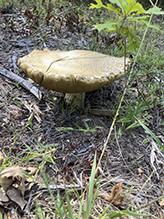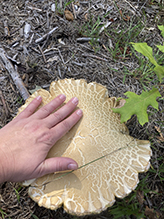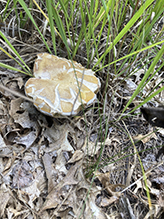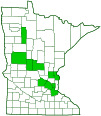Variable-stalk Bolete
(Boletus variipes)
Conservation • Description • Habitat • Ecology • Distribution • Taxonomy
Conservation Status |
|
|||||||
| IUCN Red List | not listed |
|||||||
| NatureServe | NNR - Unranked |
|||||||
| Minnesota | not listed |
|||||||
Description |
||
Variable-stalk Bolete is a common, large, woodland mushroom. It occurs in the eastern United States from New Hampshire to Florida, west to Minnesota and eastern Texas, and in southern Quebec and Ontario Canada. There is also a disjunct area of occurrence in southern Mexico and Central America. It is common in eastern North America but uncommon in Minnesota, where it reaches the northwestern extent of its range. It is found in late summer and fall, alone, scattered, or close together but not clustered (gregarious), in deciduous and mixed forests. It grows on the ground under hardwood trees, especially oak, but also beech, aspen, and possibly maple. It has a mutually beneficial relationship (mycorrhizal) with the tiny rootlets of trees, absorbing sugars and amino acids while helping the tree absorb water. As the common name and species epithet suggest, Variable-stalk Bolete is highly variable, in the size, in the cap color, and in the shape and surface texture of the stalk. When it first appears, the cap is convex, dry, and covered with fine, velvety hairs. The color may be buff, tan, yellowish-brown, or grayish-brown. As it ages it becomes broadly convex to almost flat. Mature caps are 2½″ to 8″ (6 to 20 cm) in diameter and the upper surface is cracked or finely patched. The stalk is mostly grayish-brown to dark brown, whitish just near the top and bottom. It is stout, often pot-bellied (bulbous), 3″ to 6¼″ (8 to 15 cm) long, and ⅜″ to 1⅜″ (1.0 to 3.5 cm) thick. It may be swollen in the middle, enlarged toward the base, narrowed at both ends, or more or less equal from top to bottom. The surface is usually prominently covered with a network of whitish or brownish ridges (reticulate), especially noticeable near the top. Sometimes the reticulation is reduced or fine. When young, the pore surface is white, and the pores appear full. There are 1 or 2 pores per millimeter, and the pore tubes are ⅜″ to 1¼″ (1 to 3 cm) deep. The pore surface becomes yellowish or olive with age. The flesh of the cap and stem is white. It does not change color when bruised or cut. It is edible when young, but like other boletes, mature specimens are often riddled with maggots. The spore print is olive-brown. |
||
Similar Species |
||
Habitat and Hosts |
||
Mixed and deciduous forests Oak and beech |
||
Ecology |
||
Season |
||
Late summer and fall |
||
Distribution |
||||
|
Sources |
|||
| 9/22/2022 | ||||
Occurrence |
||||
Uncommon in Minnesota |
||||
Taxonomy |
|||
Kingdom |
Fungi (fungi) |
||
Subkingdom |
Dikarya |
||
Phylum |
Basidiomycota (club fungi) |
||
Subphylum |
Agaricomycotina (jelly fungi, yeasts, and mushrooms) |
||
Class |
Agaricomycetes (mushrooms, bracket fungi, puffballs, and allies) |
||
Subclass |
Agaricomycetidae |
||
Order |
Boletales (boletes and allies) |
||
Suborder |
Boletineae |
||
Family |
|||
Subfamily |
Boletoideae |
||
Genus |
Boletus (porcini and allies) |
||
Synonyms |
|||
|
|||
Common Names |
|||
Variable-stalk Bolete |
|||
Glossary
Gregarious
In mushrooms, growing close together but not clustered.
Mycorrhizal
A symbiotic, usually beneficial relationship between a fungus and the tiny rootlets of a plant, usually a tree.
Visitor Photos |
|||||
Share your photo of this fungus. |
|||||
| This button not working for you? Simply email us at info@MinnesotaSeasons.com. Attach one or more photos and, if you like, a caption. |
|||||
AGShep |
|||||
my backyard |
|||||
 |
 |
||||
 |
|||||
MinnesotaSeasons.com Photos |
|||||
|
|||||

Slideshows |
||

Visitor Videos |
|||
Share your video of this fungus. |
|||
| This button not working for you? Simply email us at info@MinnesotaSeasons.com. Attach a video, a YouTube link, or a cloud storage link. |
|||
Other Videos |
|||

Created: 9/22/2022
Last Updated:


